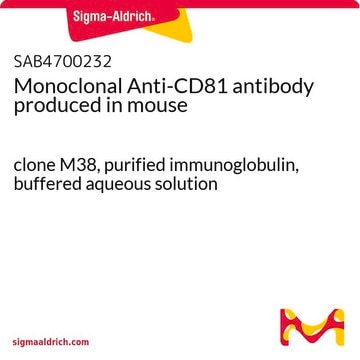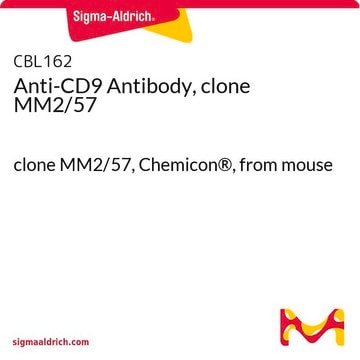MABF2061
Anti-TAPA-1 (CD81) Antibody, clone 5A6
clone 5A6, from mouse
Synonym(s):
CD81 antigen, 26 kDa cell surface protein TAPA-1, Target of the antiproliferative antibody 1, Tetraspanin-28, Tspan-28
About This Item
Recommended Products
biological source
mouse
Quality Level
antibody form
purified immunoglobulin
antibody product type
primary antibodies
clone
5A6, monoclonal
species reactivity
human
packaging
antibody small pack of 25 μL
technique(s)
flow cytometry: suitable
immunoprecipitation (IP): suitable
inhibition assay: suitable
western blot: suitable
isotype
IgG1κ
NCBI accession no.
UniProt accession no.
shipped in
ambient
target post-translational modification
unmodified
Gene Information
human ... CD81(975)
Related Categories
General description
Specificity
Immunogen
Application
Inflammation & Immunology
Immunoprecipitation Analysis: A representative lot immunoprecipitated TAPA-1 (CD81) in Immunoprecipitation applications (Clark, K.L., et. al. (2004). J Biol Chem. 279(19):19401-6; Oren, R., et. al. (1990). Mol Cell Biol. 10(8):4007-15).
Flow Cytometry Analysis: A representative lot detected TAPA-1 (CD81) in Flow Cytometry applications (van Zelm, M.C., et. al. (2010). J Clin Invest. 120(4):1265-74; Oren, R., et. al. (1990). Mol Cell Biol. 10(8):4007-15).
Inhibition: A representative lot inhibited the growth and proliferation of OCI-LY8 cell line. (Oren, R., et. al. (1990). Mol Cell Biol. 10(8):4007-15).
Quality
Flow Cytometry Analysis: 1 µg of this antibody detected TAPA-1 (CD81) in one million HUH-7 cells.
Target description
Physical form
Storage and Stability
Other Notes
Disclaimer
Not finding the right product?
Try our Product Selector Tool.
recommended
Storage Class Code
12 - Non Combustible Liquids
WGK
WGK 2
Flash Point(F)
does not flash
Flash Point(C)
does not flash
Certificates of Analysis (COA)
Search for Certificates of Analysis (COA) by entering the products Lot/Batch Number. Lot and Batch Numbers can be found on a product’s label following the words ‘Lot’ or ‘Batch’.
Already Own This Product?
Find documentation for the products that you have recently purchased in the Document Library.
Our team of scientists has experience in all areas of research including Life Science, Material Science, Chemical Synthesis, Chromatography, Analytical and many others.
Contact Technical Service







